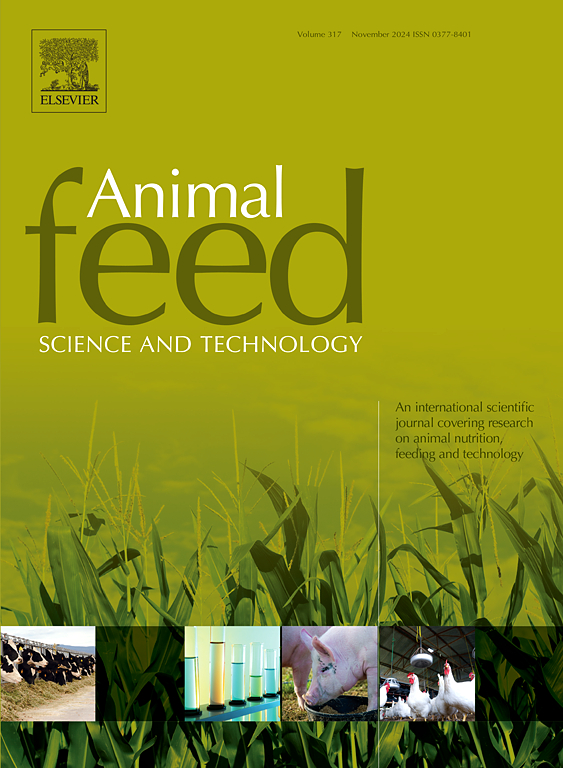饲粮中添加枸杞多糖对鳙鱼生长、抗氧化、免疫反应及肠道菌群的影响
IF 2.5
2区 农林科学
Q1 AGRICULTURE, DAIRY & ANIMAL SCIENCE
引用次数: 0
摘要
中草药多糖具有增强免疫、抗氧化、调节肠道菌群等功能,在动物中应用广泛,但在鱼类中应用较少。本试验研究了饲粮中添加枸杞多糖(LBP)对Bulatmai barbel生长性能、消化性能、免疫性能、基因表达和肠道菌群的影响。对照组接受基础饮食,而治疗组持续8周食用含有0.10 %、0.20 %和0.40 % LBP的相同基础饮食。结果表明,与对照组相比,0.10 % LBP显著提高了增重率和特定生长率,降低了饲料系数。总体而言,0.10 % LBP显著改善消化性能,提高胰蛋白酶、脂肪酶和淀粉酶功能水平。此外,0.10 %枸杞多糖显著提高了乌拉麦刺参的抗氧化活性。LBP上调热休克蛋白(HSP70)、碱性磷酸酶(AKP)和超氧化物歧化酶(SOD) mRNA表达。值得注意的是,0.10 % LBP可以增加肠道菌群的多样性和丰富度。此外,LBP增加了梭杆菌的比例存在,同时降低了变形杆菌的水平。在属水平上,它提高了鲸杆菌的比例存在。因此,本研究表明,0.10 % LBP对Bulatmai barbel的生长性能、消化性能、免疫性能、基因表达和肠道菌群有正向调节作用。枸杞多糖是一种极具发展潜力的饲料添加剂。本文章由计算机程序翻译,如有差异,请以英文原文为准。
Effects of dietary Lycium barbarum polysaccharide on the growth, antioxidant, immunity response, and intestinal microbiota in Bulatmai barbel (Luciobarbus capito)
Chinese herbal polysaccharides has the functions of enhancing immunity, anti-oxidation, regulating intestinal flora, which was widely used in animals, but rarely used in fish. This study investigated the influence of dietary Lycium barbarum polysaccharide (LBP) on growth performance, digestive performance, immune performance, gene expression, and intestinal flora in Bulatmai barbel. The control cohort received a basal diet, whereas the treatment cohorts consumed identical basal diets comprising 0.10 %, 0.20 %, and 0.40 % LBP for 8 weeks. The findings indicated that compared with the control cohort, 0.10 % LBP notably enhanced the weight gain rate (WGR) and specific growth rate (SGR), while diminishing the feed coefficient (FCR). Overall, 0.10 % LBP markedly improved digestive performance and elevated trypsin, lipase, and amylase functional levels. Additionally, 0.10 % LBP markedly increased the antioxidant activity in Bulatmai barbel. LBP upregulates the mRNA expression of Heat shock proteins (HSP70), Alkaline phosphatase (AKP), and Superoxide dismutase (SOD). Of note, 0.10 % LBP can increase the diversity and richness of intestinal flora. Furthermore, LBP enhanced the proportional presence of fusobacteria while reducing proteobacteria levels. At the genus level, it elevated the proportional presence of Cetobacterium. Therefore, this study has shown that 0.10 % LBP positively regulated growth performance, digestive performance, immune performance, gene expression, and intestinal flora in Bulatmai barbel. LBP is a feed additive with excellent potential.
求助全文
通过发布文献求助,成功后即可免费获取论文全文。
去求助
来源期刊

Animal Feed Science and Technology
农林科学-奶制品与动物科学
CiteScore
6.00
自引率
6.20%
发文量
266
审稿时长
3 months
期刊介绍:
Animal Feed Science and Technology is a unique journal publishing scientific papers of international interest focusing on animal feeds and their feeding.
Papers describing research on feed for ruminants and non-ruminants, including poultry, horses, companion animals and aquatic animals, are welcome.
The journal covers the following areas:
Nutritive value of feeds (e.g., assessment, improvement)
Methods of conserving and processing feeds that affect their nutritional value
Agronomic and climatic factors influencing the nutritive value of feeds
Utilization of feeds and the improvement of such
Metabolic, production, reproduction and health responses, as well as potential environmental impacts, of diet inputs and feed technologies (e.g., feeds, feed additives, feed components, mycotoxins)
Mathematical models relating directly to animal-feed interactions
Analytical and experimental methods for feed evaluation
Environmental impacts of feed technologies in animal production.
 求助内容:
求助内容: 应助结果提醒方式:
应助结果提醒方式:


